#Streamline Order Processing
Explore tagged Tumblr posts
Text
Simple Online Order Management Software
Having an Order Management System is important in today’s business environment and especially useful in managing day to day orders received. For a small business owner or someone in charge of a rapidly developing company, the presence of an online Order Management System is as beneficial as a double-edged sword – both for the owner and the development of their business. Since each new order requires monitoring, invoicing, and inventory management, an order management system can take care of these tasks more easily and excellently.

Order management system for small business is one such investment that can greatly enhance the functional capabilities of a small business. It is useful right from the moment when a client places an order up to the time when the order is completed. You can track every order in real-time, thus customers will always be satisfied by the fast and efficient deliveries. It enables you to minimize mistake, eliminate issues with socks or lack of stock, and better your overall service delivery.
An online order management system is not only a tool for dealing with customer orders, it offers the ability to interact with sales channels, receive payments, and look at your sales data. In fact, what you can do is that with each single order you have, every single status of inventory, and shipping, and everything in one single dashboard you can run your business and expand it at a better pace.
In conclusion, regardless of the size of the store, being an offline store or an online store, the Order Management System will bring a big improvement to your work so that you can reduce time on other aspects and focus more on the development and improvement of your store and customer service. Check out our solutions and find out just how effortlessly you could enhance your order management right now.
#Order Management System#Online Order Management System#Order Management System for Small Business#Small Business Order Management#Streamline Order Processing#Order Tracking System
0 notes
Text
breasting boobily down the isles of department stores on a hunt for a bra that is actually my size and then breasting boobily to the exit empty handed
#I don’t want to order one online just yet I gotta try it on yknow#and indecent it may be but if I show without a bra it streamlines the trying on process and so#but fuck! my size is hard to find in the real world
2 notes
·
View notes
Text
Order Food Using AI: The Key to Boosting Restaurant Revenue
Technology might be the ace in the competitive world of restaurants. One of the most interesting new developments is using artificial intelligence in ordering food. Integrate AI into the ordering system of your restaurant, and owners will definitely raise their revenues significantly, increase customer satisfaction, and even achieve operational efficiency. Here's how systems that let customers order food using AI can revolutionize your business.
1. Customer Experience
Personalized Recommendations
AI-driven systems can use customer data to make personalized food recommendations. Since AI knows about your previous orders and food preferences, it could very well suggest dishes that would cater to your taste buds. Not only will such personalization enrich the dining experience, but it could also be used for the possibility of upselling or cross-selling for more revenue generation.
Seamless Ordering Process
AI simplifies ordering through intuitive interfaces and voice-activated systems. This fast, easy ordering minimizes customer wait time, thus improving customer satisfaction. A smooth ordering experience will motivate repeat business and more frequent customer visits.
2. Higher Accuracy of Orders
Reduces Human Error:
Manual order-taking is prone to mistakes, which leaves customers unsatisfied and rips the business of money. AI systems reduce these mistakes with accurate order-taking and capturing every detail. With this, there will be reduced mistakes and more satisfaction among customers since the orders are made according to their desires.
Real-Time Updates
It allows for real-time order status updates to be provided to the customers right from food preparation to delivery. This kind of transparency will help in building trust while keeping customers updated on any orders placed by them. Such features reduce the number of inquiries and, hence, improve the experience.
3. Streamlined Operations
Order Management Efficiency
High volumes of orders can be processed quickly because AI manages orders using automatic systems that set priorities and allow proper organization. This ensures that the orders are out quickly and reduces the volume of staff, so there is more time to offer great service.
Streamlining Kitchen Workflow
The AI systems can also be integrated with the kitchen display systems so that the preparation is done in an orderly and time-saving manner. Orders are communicated directly to the kitchen, where they are streamlined and managed in a very organized way. This would reduce the preparation time and help in delivering the dishes faster and on time.
4. Increasing Revenue through Upselling
Intelligent Upsell
It can further gauge customer data to identify opportunities for upselling. For instance, if a customer has ordered a main course, AI will offer the best-matching sides or beverages. Intelligent upselling increases the average order value and maximizes revenues from each customer.
Targeted Promotions
AI can provide personalized promotions to customers as per the trends in behavior and ordering history. This step can incentivize repeat business and higher sales with special offers or discounts for repeat customers. AI-driven promotions are more effective since they are attuned to the preferences of individual customers.
5. Harnessing Information to Drive Strategy
Analyzing Trends from Customers
AI systems provide very useful insights into customer behavior and ordering patterns. Therefore, restaurant owners can analyze trends in this data to come up with informed decisions on menu changes, pricing strategies, and marketing efforts. Understanding customer preference helps in crafting strategies that drive growth.
Forecasting Demand
AI can project from past data and trend analysis, which helps with inventory management, employee scheduling, and optimal resource allocation. If demand can be forecasted accurately, then a restaurant is well geared up in advance for those busy times of the day when demand will be high enough to maximize revenues from your restaurant.
6. Improvement in Marketing Efforts
Data-driven Marketing Campaigns
AI will help you in segmentation and the creation of focused marketing campaigns. AI, knowing customers' preferences and behavior, makes it easier to draft personalized marketing messages that appeal most to your target audience. These campaigns are thus very effective in generating maximum traffic and increasing sales.
Social Media Integration
It can also be managed using AI tools and post-scheduling to analyze the interaction and engagement of social media. Ensure that your restaurant remains very lively on social media to hook more new customers and keep existing ones engaged. Relevance and visibility from social media integration with AI means increased interest in your restaurant.
7. Customer Retention Improvement
Loyalty Programs
AI may optimize reward programs by understanding the behavior of each customer and making personalized offers. When rewards are individually tailored to a diner's preference, he or she will likely come again and again, ensuring long-term loyalty. A good loyalty program would indeed transform diners into regular customers.
Seeking Feedback and Improvement
AI can collect and analyze customer feedback to point out their areas of improvement. It helps in understanding the level of customer satisfaction and solving their problems effectively improving service quality and maintaining a good reputation. With an emphasis on continuous improvement according to the feedback, it improves the dining experience overall.
Conclusion: Make Your Restaurant Thrive with AI
Ordering with AI isn't another fad; it is how your restaurant will increase its revenues and efficiency. From improving the customer experience and increasing order accuracy and smoothing operations to harnessing data, AI holds immense potential for changing how your restaurant functions and excels in a saturated market.
Explore AI-driven food ordering solutions available at eatOS for a whole new scale of growth and profitability opportunities. Make that bright future of restaurant management come through; let it start with AI! Book a demo now with us to learn more.
#Restaurant#Loyalty Programs#Restaurant Revenue#order food using AI#Seamless Ordering Process#Streamlining Kitchen Workflow
0 notes
Text
New Post ‹ Site Title — WordPress.com
https://wordpress.com/post/amanandrabiaonline.wordpress.com?url=https%3A%2F%2Fwordpress.com%2Fgo%2Fcontent-blogging%2Fsetting-your-podcast-marketing-strategy-three-key-steps%2F%3Fpage_id%3D18003265&is_post_share=true&v=5 Aman and Rabia Enterprise can leverage various AI tools to enhance productivity and streamline their operations in the Ethiopian cultural clothes industry. One such tool is…

View On WordPress
#AI tools for image recognition and virtual fitting rooms can revolutionize the online shopping experience for customers#AI-powered demand forecasting tools can help Aman and Rabia Enterprise optimize their inventory management#allowing them to make data-driven decisions and tailor their products to meet consumer needs effectively. Additionally#allowing them to visualize how the cultural garments will look on them before making a purchase. By implementing such tools on their e-comme#Aman and Rabia Enterprise can gain valuable insights into customer preferences#Aman and Rabia Enterprise can increase customer engagement#Aman and Rabia Enterprise can leverage various AI tools to enhance productivity and streamline their operations in the Ethiopian cultural cl#Aman and Rabia Enterprise can unlock new opportunities for growth#and deliver a seamless and personalized experience to their customers in the Ethiopian cultural clothes industry.#and drive sales. In conclusion#and external factors#and market trends#and maximize profitability. Furthermore#and minimize excess inventory costs. By analyzing historical sales data#and personalize marketing campaigns. By utilizing AI-powered analytics#and provide personalized recommendations#automating repetitive tasks through AI-based tools such as chatbots or virtual assistants can free up valuable time for the team to focus on#buying patterns#by integrating AI tools strategically into their workflow#enabling the company to optimize production schedules#enhancing the overall shopping experience for customers while improving operational efficiency for Aman and Rabia Enterprise. Moreover#improve operational efficiency#market trends#minimize waste#process orders#reduce return rates#reduce stockouts#these tools can predict future demand accurately#track sales leads#which can help them efficiently manage customer interactions
0 notes
Text










Hello everyone. My floral bust portrait commissions are open.
I have a small queue, and I figured I will open another couple of slots for more breathing room as I finish this queue.
ETA is late March to early April. They are only 35 usd each portrait, and they are priced down from my original 45 usd.
They are priced down as I am a slower artist- I currently have three jobs, and the sole caretaker of a completely disabled mother whose movement is very limited and dependent on able bodied people, partially disabled father, and an autistic sister, who I am sending to school- that means, as I am essentially a parent to all three- my time is very limited, and so because of the longer 3-4 weeks wait, I charge lower.
I draw tieflings, elves, humanoids, dnd characters that are human-like, ocs, tavs from baldurs gate, etc etc- I specialize in ocs of all shapes and sizes-
I can not draw: non human ocs, ocs with their faces covered, I cannot draw real humans: for example: "can you draw my gf?"- real human faces take far longer to draw and stylize in a way that will look like irl people. This means I can not draw furry or mecha as well.
I will only draw busts. Please, please only hire me for what I am advertising, if you feel my art style will fit your oc. You will receive a portrait of your oc with a floral background from the chest up.
You can choose the expression, the clothes, the hairstyle, the flower style, the general color and mood of the piece, and you will have two passes of edits for free.
❌️ "can you draw this scene from a book"
❌️ "can you draw my grandma"
❌️"can you draw my room and a person sitting in that chair"
These instructions are very long, but I've been, drawing for 5 years for folk now, hehe, and in order to streamline my drawing process, I need to become more and more specific with my instructions 😞 I sometimes get requests to draw entire fully rendered drawings in my portrait commissions!
I am requesting for more patient clients! I do my best to meet everyone's expectations, but I also would love folk who understand that I am one person who loves other people's ocs and want to portray them with love and dignity, and that I am working on these highly specialized and specific and personalized portraits, oftentimes 10 at any given time.
Thank you for reading, please let me work for you! I am a disabled artist from the global south, just trying to get by!
Hire me, send me tips, commission me please!
1K notes
·
View notes
Text

The Northern Passage has been updated!
09.25.24: This update consists of what was previously the prologue; it's now our new Chapter 1. Heavy edits have been made and various scenes have been rewritten, as well as overall improvements with the combat system and lore to make the game more cohesive.
The demo, for the time being, will cut off at the end of this new Chapter 1. My plan is to continue editing and rewriting Chapter 2 (what was previously the first chapter after the prologue) and hopefully rerelease that relatively soon, and then complete the new content update and release all of Chapter 3. This process, while tedious, is helping me tremendously with streamlining code & fixing previous mistakes made by me when I first started this project, and while I wanted to avoid going back and editing originally until much later in the process, this is just something that I had to do in order to move forward with Chapter 3.
I've also updated the content warnings on the game page and allowed for players to turn on warnings in-game, so you get a more specific list of warnings at the start of each chapter (like with Blood Choke).
As always, please let me know if you run into any errors, especially since part of this rewrite included me redoing a lot of my messy code and renaming passages, etc. Thank you everyone for your patience and continued support of this game over the years 💕
Play it here!
Project Intro | FAQ | Tip Jar
889 notes
·
View notes
Text
time to post the prompt I tormented @bloggerspam with on discord >:) Danny and Jason died at the same time and parts of their core jumped into each others cores, making them literal soulmates. They feel a burning tug deep in their chest ever since they got brought back to life, a desperate yearning, there’s some part of themselves that is missing. They feel hollow. After a bad coming out (as Phantom, not out of the closet) with his parents, Danny decides to follow that tugging sensation... all the way to Gotham City, where a certain crime lord also is yearning for something he can’t quite place. During the time Danny arrives in Gotham, the sense of yearning and hollowness strengthens in Jason. He doesn't know what's going on. His family is worried for him. Jason's new bedtime routine is gently rubbing a spot just to the right of his heart, silent tears running down his cheeks as he yearns for the touch of a person he's never met. It's confusing and frightening. All he knows is that the pain in his chest is now even stronger. The hollowness he's felt ever since he crawled his way out of his grave spreading past a sense of yearning and progressing to an agonizing longing. Jason tested himself for every type of Ivy's pollen and it came back negative. He doesn't know what's going on and he's scared. For Danny it's similar. The tug of his core is even stronger in Crime Alley. Every night he weeps holding his hands around his core feeling it softly cry for its other half. He knows they're nearby but he doesn't know how to pinpoint their location. All he can do is wait and hope that they stumble across each other. Danny decides to take action. He steals some of Vlad’s money and opens a coffee shop in the Narrows. Danny can feel the tugging so much stronger here. He hopes he can find what his core is looking for. Danny first meets this one extremely tired looking teen in a nice suit who always looks dead on his feet and asks for an ungodly amount of caffeine. Danny happily gives him the borderline toxic order. The man keeps on coming to his shop and they start to get to know each other. Unknowingly, Danny has become fast friends with a billionaire CEO. After multiple agonizing weeks, Tim brings his brother to the new shop that opened in his territory that sells incredibly good coffee for a concerningly low price... Danny is just working at his cafe on another average day when the door opens and in walks Tim and Him. A tall and built man with a white streak in his hair who's staring at Danny like he hung the stars in the sky.
The second their eyes locked,,, they felt whole. For the first time in years the yearning pain is no longer.
After meeting they realized a problem. It's genuinely agonizing being apart for more than a half an hour as their cores are finally healing from tearing themselves apart in their desperation to find their other half. This streamlines getting to know each other with the forced closeness. Tim helps Jason and takes over his patrols in Crime Alley as their cores mend. They found out that physical touch helps speed up the process greatly which meant the optimal way to speed up their cores healing was to sleep in the same bed.
During this time, both Danny and Jason's ghostly instincts are in overdrive. Danny and Jason both unknowingly are courting each other in a ghostly fashion and are unknowingly accepting the courting from each other, leading to an unintentional ghostly marriage (They aren't too freaked out about it when they figure out they're technically married according to Infinite Realms customs. It completes the mending of their cores after all.)
#dpxdc#danny phantom#dp x dc#bones prompts#its a long one. behold my thoughts.#it was a blast writing this#I changed some stuff to make it more coherent
917 notes
·
View notes
Text



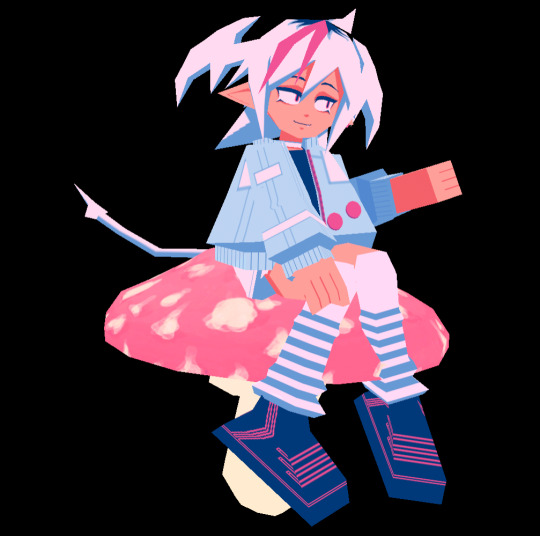

Hey friends and fans, I'd like to join vgen in order to streamline my commission process. I'm codeless, so that means I'm counting on you to help me!
All you have to do is like + comment on this post. To be completely transparent, I need 5 unique comments + 100 likes to be considered, and reblogs will of course help me get there even faster.
For those of you who don't know me, my name is Daxe and I'm a trans artist. I make 2D and 3D art and have a love for the fantastical and strange. You might've seen my work on the covers of glass beach's albums. I run a monthly sticker club on my patreon, I also regularly stream art on twitch, and I'm working very hard to support myself full time with my art. This is just another step in that direction! vgen.co/daxe


Thanks for all your support!!!
313 notes
·
View notes
Text
Round 3 - Actinopterygii - Clupeiformes




(Sources - 1, 2, 3, 4)
Order: Clupeiformes
Common Name: no common name for the whole order, variously called “herrings”, “sprats”, and “shads”
Families: 10 - Denticipitidae (“Denticle Herring”), Spratelloididae (“round herrings”), Engraulidae (“anchovies”), Clupeidae (“herrings”, “Pacific Menhaden”, and “sprats”), Chirocentridae (“wolf-herrings”), Dussumieriidae (“rainbow sardines” and “round herrings”), Pristigasteridae (“longfin herrings”), Ehiravidae (“river sprats”), Alosidae (“shads”), and Dorosomatidae (“sardinellas”, “gizzard shads”, “Smooth-belly Pellonuline”, “white sardines”, and kin)
Anatomy: generally silvery, streamlined, spindle-shaped bodies; most filter plankton from the water with gill rakers; gas bladder has a pneumatic duct connecting it to the gut; typically lack a lateral line
Diet: mainly plankton, some eat smaller fish
Habitat/Range: in oceans worldwide; some anchovies will enter brackish water and some are restricted to fresh water
Evolved in: Early Cretaceous

Propaganda under the cut:
The Clupeiformes are some of the most important food fish, both for larger fish, birds, mammals, and for humans, who will also use them as bait. As small schooling fish, many are known for making “bait balls” (see gif above) when threatened, where the fish will swarm in a tightly packed sphere to seem larger and protect themselves, as lone individuals are more likely to be eaten than an individual in a large group. Bait balls are short-lived and seldom last longer than 10 minutes. Some predators have developed sophisticated countermeasures to bait balls, which can seriously undermine the defensive value of a bait ball. Some predators will work together to herd the fish into a ball before striking them all together, and humans will use nets to catch the entire school.
The Denticle Herring (Denticeps clupeoides), the only member of its family, in known for its array of denticle-like scales under the head, which give it almost a furry appearance
The Peruvian Anchoveta (Engraulis ringens) is one of the most commercially important fish species in the world, with annual harvests varying between 3.14 and 8.32 million tonnes. The top yield was 13.1 million tonnes in 1971, but has undergone great fluctuations over time. Canned Anchovetas are sometimes marketed with the culinary name "Peruvian Sardines" to promote domestic and international consumption, as sardines are usually in higher demand. Only 1% of Anchoveta catches are used for direct human consumption, while 99% are rendered into fishmeal and oil. The Anchoveta has been characterised as "the most heavily exploited fish in world history". After the population has been greatly reduced by overfishing and El Niño events, smaller quotas have been placed on Anchoveta fisheries.
The strong taste people associate with anchovies is due to the curing process, as they are salted in brine and packed in oil and salt.
As with all filter feeders, Clupeidae (“herrings” and “sprats”) cannot take in food if nutrient rich water does not pass over their gills. To moderate this, members of this family have been found to increase their swimming speed when they sense that there is a high concentration of food items in order to take advantage of the feeding period.
Both species of wolf-herring (genus Chirocentrus) have elongated jaws with long sharp teeth that aid their ravenous appetites, primarily for other fish. The Whitefin Wolf-herring (Chirocentrus nudus) is also known to crunch on crabs, in addition to its usual diet of smaller fish.
The Rainbow Sardine (Dussumieria acuta) is iridescent blue with a bit of shiny gold or brass line below, but these brilliant colors quickly fade after death.
The American Shad (Alosa sapidissima) has been described as "the fish that fed the (American) nation's founders".
The Pokémon Wishiwashi is based on the Pacific Sardine (Sardinops sagax ocellatus), and can turn into a “school form” made up of hundreds of other Wishiwashi when it enters battle. The School Form resembles a larger fish and is based off of a bait ball.
164 notes
·
View notes
Text





🎄💾🗓️ Day 4: Retrocomputing Advent Calendar - The DEC PDP-11! 🎄💾🗓️
Released by Digital Equipment Corporation in 1970, the PDP-11 was a 16-bit minicomputer known for its orthogonal instruction set, allowing flexible and efficient programming. It introduced a Unibus architecture, which streamlined data communication and helped revolutionize computer design, making hardware design more modular and scalable. The PDP-11 was important in developing operating systems, including the early versions of UNIX. The PDP-11 was the hardware foundation for developing the C programming language and early UNIX systems. It supported multiple operating systems like RT-11, RSX-11, and UNIX, which directly shaped modern OS design principles. With over 600,000 units sold, the PDP-11 is celebrated as one of its era's most versatile and influential "minicomputers".
Check out the wikipedia page for some great history, photos (pictured here), and more -
And here's a story from Adafruit team member, Bill!
The DEC PDP-11 was the one of the first computers I ever programmed. That program was 'written' with a soldering iron.
I was an art student at the time, but spending most of my time in the engineering labs. There was a PDP-11-34 in the automation lab connected to an X-ray spectroscopy machine. Starting up the machine required toggling in a bootstrap loader via the front panel. This was a tedious process. So we ordered a diode-array boot ROM which had enough space to program 32 sixteen bit instructions.
Each instruction in the boot sequence needed to be broken down into binary (very straightforward with the PDP-11 instruction set). For each binary '1', a diode needed to be soldered into the array. The space was left empty for each '0'. 32 sixteen bit instructions was more than sufficient to load a secondary bootstrap from the floppy disk to launch the RT-11 operating system. So now it was possible to boot the system with just the push of a button.
I worked with a number DEC PDP-11/LSI-11 systems over the years. I still keep an LSI-11-23 system around for sentimental reasons.
Have first computer memories? Post’em up in the comments, or post yours on socialz’ and tag them #firstcomputer #retrocomputing – See you back here tomorrow!
#dec#pdp11#retrocomputing#adventcalendar#minicomputer#unixhistory#cprogramming#computinghistory#vintagecomputers#modulardesign#scalablehardware#digitalcorporation#engineeringlabs#programmingroots#oldschooltech#diodearray#bootstraploader#firstcomputer#retrotech#nerdlife
291 notes
·
View notes
Text
"Trolls think fashion is stupid" is code for 'trolls don't prioritise individuality' the same way "[t]rolls don't have mail" is code for 'trolls lack freedom'; while Sburb offers its human heroes the opportunity to launch into adulthood by customising their looks to express their unique personalities, the trolls are seemingly taught from a young age to avoid this kind of thinking in order to streamline the process of playing Sgrub. So for Vriska to finally graduate from the black tee with her astrological sign on it would also be a significant symbol of growing out of her Alternian mode of thinking in that respect
426 notes
·
View notes
Text
The PledgeManager has launched!
Thank you for bearing with us. We’re happy to say that, as promised, the PledgeManager has officially launched!
In case you missed it, we detailed earlier this week that the publication of the graphic novel has been pushed back from its original July 2024 estimate into Spring 2025 - you can read the full update here. We also want to take a moment to say that we have seen the outpouring of love and support on Kickstarter, and across various platforms, wishing Colleen well in her recovery and the time needed for the graphic novel - a huge thank you from all of the team for your understanding and patience, and for the genuine community and care we’ve seen these past few days. We appreciate you all.
PledgeManager
With this in mind, we think it’s important to underline: though PledgeManager has launched, you do not need to pay for your shipping fees immediately.
The PledgeManager is there for those who missed the campaign to order the graphic novel, and indeed for any backers who would like to upgrade, get some other add-ons, or the new items. You, as a pre-existing backer, should receive an email with information via Kickstarter and/or PledgeManager to inform you that this is now open to you - note, these are sent in waves of smaller batches, so if you don't get yours immediately, don't panic! It will likely take between 12-18 hours to process all the backers.
You are, of course, welcome to pay your shipping right away if you'd like, however we completely understand that you may want to wait until closer to the fulfilment time, or when more solid dates are confirmed, before actioning this.
For this stage, we have compiled a quick FAQ below covering some key questions:
Will the whole project be moving from Kickstarter to PledgeManager? No. This is just for the fulfilment side and logistics - all updates will still remain here.
Do PledgeManager backers get everything that Kickstarter backers do? No. While the remaining tiers will be made available for those who missed it, with certain stretch goals (e.g. additions to the book, loot boxes, etc), Kickstarter backers have a number of exclusives such as the Good Omens HQ discount code for when the store launches, and the backers only events.
My PledgeManager address will be different to what is listed on my Kickstarter. Is that fine? Yes. We are handling all logistics through PledgeManager and, as such, that is the only place where we will need your address. If you move or need to change any details, that will be the place to do so.
Can I change my address? Yes. You can update your address until we are at the shipping stage. We will keep this option open for as long as possible to ensure maximum flexibility around this.
How are shipping fees calculated? It is based on both weight and the country it is being sent to. We have been working over the past months to streamline processes and bring the costs down from their original starting point.
Do I have to pay just now? You do not need to pay immediately, but payment will need to be made prior to your items being shipped. You now have a bigger window during which you can make payment. As above, we will keep updating you on the progression of the publication schedule, should you be waiting for firmer dates before doing so.
What about taxes and import duty? UK: VAT is included in the costs UK backers pay, there should be no extra tax charges. US: We believe (but cannot guarantee) that imports under $800USD in value should not attract import duty, those pledges above may be taxed at import. EU & REST OF THE WORLD: If taxes or duties apply to your pledge, these will need to be paid at time of import into your country. We’ve spent months trying to integrate the costs at this stage, but in having the project open across the globe, it has proven too complex to be able to fully refine and cover all instances and locations, and we’ve been advised that this is the best route forward. We know a lot of international backers, particularly in the EU – for example – will already be used to this process, and we will keep you all updated on any developments on this front. For all of our backers, we are working hard to make labelling and declaring all of the contents of your pledges as transparent as possible, in order to make taxing and importing as easy and affordable as possible.
I want to buy the new items, but am waiting to pay shipping. Are they limited? The pins, mugs, notebooks - all the new items specifically added to the PledgeManager are not limited and will be available regardless of whether you get them now, or months down the road. The only limited items are the remaining tiers that have moved over from the Kickstarter (e.g. the Obsidian Tier) that were limited to begin with, and a very limited run of the Alien Parking ticket. Everything else is fully available, in perpetuity.
Will you be adding extra items to the PledgeManager? No. What is there at launch is all we plan to include at this point - any new items afterwards will instead originate via the Good Omens HQ store.
Will Kickstarter backers get items first? Yes. We will have a staggered approach for fulfilment: Kickstarter backers, then PledgeManager, then everything that is moving to the Good Omens HQ store will subsequently be made available.
You can also view the more general PledgeManager FAQ at terrypratchett.com.
We will keep PledgeManager and logistical notes present in all the monthly updates going forward, but felt this warranted a dedicated one-off.

These are available as part of the PledgeManager. Another beauty from our pin designer, Carl Sutton.
Thanks again for your patience. Back in the April monthly update.
In short: :)
The Good Omens Pledge Manager has launched:
those who missed the Graphic Novel Kickstarter: Now you can order the Graphic novel, not all things that were in the original Kicstarter are available but there is stil a lot of options and fuckton of lovely ineffable add-ons! :)<3
those who participated inthe original GO GN Kickstarter: you should an email (Dunmanifestin needs more information to fulfill your reward) with a link that logs you (if not log manually) into the pledgemanager and lets you edit the order (add new add ons) (yep, my wallet weeps :D<3)
The addons:



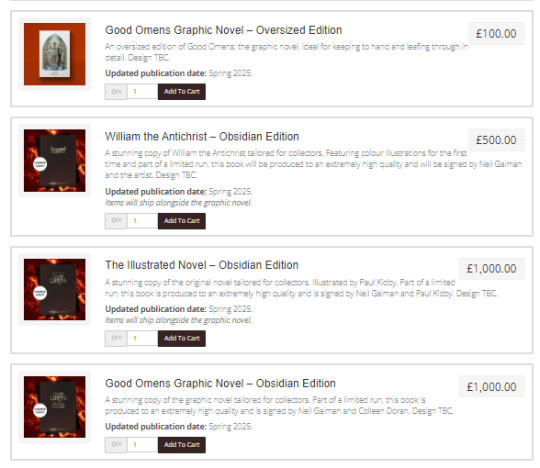
I mean... how can one resist for example these I do not know... :D
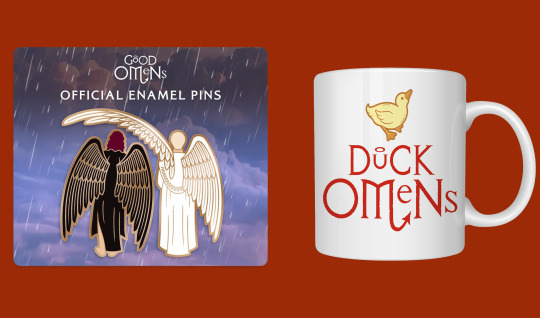
#good omens graphic novel#good omens#graphic novel#graphic novel kickstarter#merchandise#good omens merchandise#wahoo!
657 notes
·
View notes
Text
Axolt: Modern ERP and Inventory Software Built on Salesforce
Today’s businesses operate in a fast-paced, data-driven environment where efficiency, accuracy, and agility are key to staying competitive. Legacy systems and disconnected software tools can no longer meet the evolving demands of modern enterprises. That’s why companies across industries are turning to Axolt, a next-generation solution offering intelligent inventory software and a full-fledged ERP on Salesforce.
Axolt is a unified, cloud-based ERP system built natively on the Salesforce platform. It provides a modular, scalable framework that allows organizations to manage operations from inventory and logistics to finance, manufacturing, and compliance—all in one place.
Where most ERPs are either too rigid or require costly integrations, Axolt is designed for flexibility. It empowers teams with real-time data, reduces manual work, and improves cross-functional collaboration. With Salesforce as the foundation, users benefit from enterprise-grade security, automation, and mobile access without needing separate platforms for CRM and ERP.
Smarter Inventory Software Inventory is at the heart of operational performance. Poor inventory control can result in stockouts, over-purchasing, and missed opportunities. Axolt’s built-in inventory software addresses these issues by providing real-time visibility into stock levels, warehouse locations, and product movement.
Whether managing serialized products, batches, or kits, the system tracks every item with precision. It supports barcode scanning, lot and serial traceability, expiry tracking, and multi-warehouse inventory—all from a central dashboard.
Unlike traditional inventory tools, Axolt integrates directly with Salesforce CRM. This means your sales and service teams always have accurate availability information, enabling faster order processing and better customer communication.
A Complete Salesforce ERP Axolt isn’t just inventory software—it’s a full Salesforce ERP suite tailored for businesses that want more from their operations. Finance teams can automate billing cycles, reconcile payments, and manage cash flows with built-in modules for accounts receivable and payable. Manufacturing teams can plan production, allocate work orders, and track costs across every stage.
86 notes
·
View notes
Note
Nick Bostrom's "Fable of the Dragon Tyrant," which CGP Grey adapted into a video, left me feeling unsatisfied, and I got a certain unsettling vibe about the entire story.
I don't think it was the dragon's lack of agency, that just makes it an unusually traditional Western dragon.
You're a master at picking narratives apart to figure out why they don't satisfy. Do you have any insight, opinions, or cracktheories about why this story might be unsatisfying to some folks?
Probably because it's a very unsubtle metaphor casting the dragon as death, and death itself as a cruel, malevolent beast devouring and subjugating humanity for its own whims. This is very much intentional on the part of the writer. The paradigm of the story is that the dragon is huge, terrifying and incalculably cruel, and everyone lives their lives in the shadow of its terror or are just too deluded to recognize that it's COMING TO EAT THEM OH GOD
Intrinsic in this metaphorical structure is the idea that the dragon, aka death, is an artificial imposition on the natural order, and if we just got rid of the big ol' mean dragon, everybody would live forever and be fine. Accepting that the dragon exists is framed as a sign of desperation or even cowardice. This is an understandable read when facing a monster that only SEEMS timeless and inevitable (like LeGuin's thoughts comparing the current state of capitalism to the historical acceptance of the divine right of kings) but becomes bizarre when applied to something as legitimately factual as biological death. It's not even framed as unnatural death - the dragon specifically gets sent mostly old people. The metaphor is very explicitly about trying to frame death from old age as a big horrible dragon that everyone only thinks is unstoppable.
I get what they're going for here. The purpose of this story is to make the audience question if death is a true inevitability or if it can be fought, staved off, even defeated. But in the process, the story frames the systems of the world that have formed around death - doctors, pallative caregivers, will executors - as macabre gears in the machine dedicated to the genocidal cruelty of feeding the dragon.
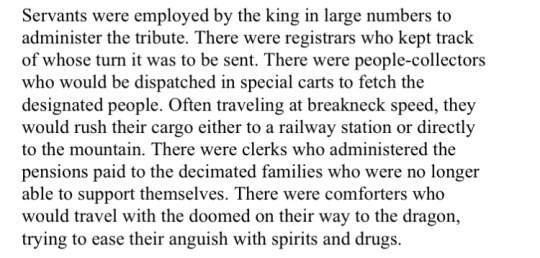
In the dragon tyrant framing, these people only exist to make the rest of the world more okay with flinging themselves down the gullet of the dragon and to streamline the process by which everybody dies. By casting death as the enemy, everybody whose jobs are based on the compassionate act of comforting and aiding people suffering from loss become reframed as collaborators with the incalculably evil enemy, and everyone who's ever accepted their own death becomes a loser. This is a deeply cruel way to frame people who dedicate their lives to helping people through one of the hardest and most tragic aspects of life.

Damn, that's fucked up. Look at this eloquent idiot, explaining why we should be okay with letting a big dragon eat us because it's the natural order. Clearly he is wrong and it's not debasing at all to want to stay alive and not get eaten by a big dragon. This is a fallacy of false analogy: death is like being eaten by a big mean dragon. All his arguments look ridiculous when applied to getting eaten by a big mean dragon, therefore they must be ridiculous when applied to dying when your organs start failing because they've been running nonstop for nine decades and biological systems accumulate wear and tear like literally everything else in the universe.
Entropy increases; systems break down, from DNA to planetary orbits. Successfully shoot down the dragon and you'll end up outliving everything you thought was eternal, even the stars. The goal of immortality isn't really to personally witness the sun exploding, it's to have more good time. It's to make your twenties last into your sixties. It's to keep your back painless and your vision good for longer. We want to postpone the story's end as long as we can, and so we extrapolate "more time" into "I never want to die, I want to be young and healthy and hot forever" even though "forever" doesn't exist. To look to "forever" is to understand that your culture and language will drift, your home will eventually crumble out from under you, your shoreline will erode and change, your climate will transform, your tectonic plate will subduct or shatter, your moon's orbit will slow and tidally lock, and eventually your sun will start burning helium and cook your planet. You don't want "forever" to look like that, you want it to look like your twenties felt. But at that point you aren't fighting the Big Mean Dragon That Eats People, you're fighting the ocean and the biosphere and the earth and the stars, trying to hold them in place against entropy so your immortality can have an equally immortal world to enjoy it in. No, this argument doesn't want true immortality, it wants their twenties to last longer. But it can't admit that.
Back to the story. There's a condescending and spiteful tone in the narration. Death (being eaten by a big mean dragon) is OBVIOUSLY awful and we should all be fighting as hard as we can to make it stop happening. Even a child can see it.
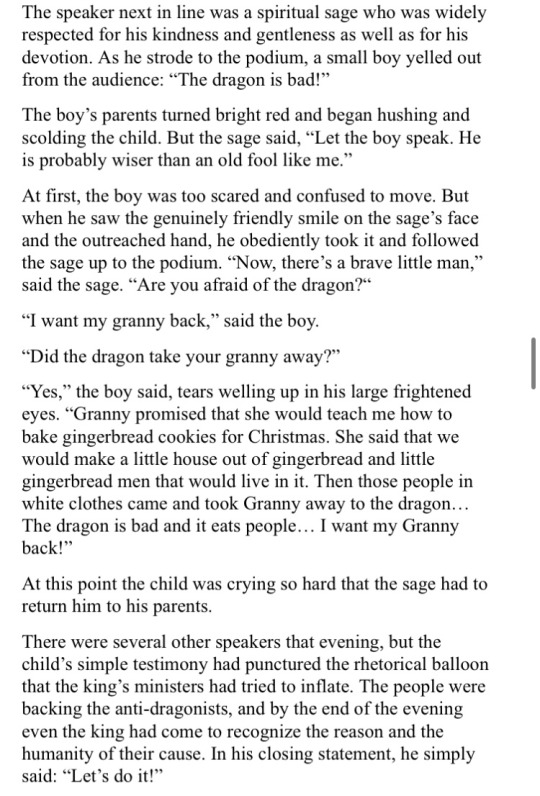
The story even helpfully adds a lengthy moral explanation at the end, in case you didn't understand that the dragon was the inevitability of death and we should dedicate all our resources to figuring out how to make a big rocket and shoot it.
"Nobody should ever die" is generally understood to be a childish dream with extremely obvious and unpleasant consequences that would turn its realization into an unending and waking nightmare, and once out of the confines of easy metaphor, the story tries to act like that wasn't what it was just saying. But its more realistic proposed substitute, "It would be great if people could live longer and have more healthy, youthful years in them," is probably the world's most uncontroversial statement. This story frames it like a bold revelation that the world will attempt to beat down and crush out of a misguided acceptance that Big Mean Dragon comes for us all. It's a morality fable whose conclusion is "I hope science improves the length and quality of our lives, potentially even to the point where we never have to die at all," which has been the number one goal of huge swaths of science since the invention of agriculture. This is not a bold or controversial take. It's just being written as though we're all looking at the naked emperor and pretending he's wearing pants.
616 notes
·
View notes
Text
New Post ‹ Site Title — WordPress.com
https://wordpress.com/post/amanandrabiaonline.wordpress.com?url=https%3A%2F%2Fwordpress.com%2Fgo%2Fcontent-blogging%2Fsetting-your-podcast-marketing-strategy-three-key-steps%2F%3Fpage_id%3D18003265&is_post_share=true&v=5 Aman and Rabia Enterprise can leverage various AI tools to enhance productivity and streamline their operations in the Ethiopian cultural clothes industry. One such tool is…

View On WordPress
#AI tools for image recognition and virtual fitting rooms can revolutionize the online shopping experience for customers#AI-powered demand forecasting tools can help Aman and Rabia Enterprise optimize their inventory management#allowing them to make data-driven decisions and tailor their products to meet consumer needs effectively. Additionally#allowing them to visualize how the cultural garments will look on them before making a purchase. By implementing such tools on their e-comme#Aman and Rabia Enterprise can gain valuable insights into customer preferences#Aman and Rabia Enterprise can increase customer engagement#Aman and Rabia Enterprise can leverage various AI tools to enhance productivity and streamline their operations in the Ethiopian cultural cl#Aman and Rabia Enterprise can unlock new opportunities for growth#and deliver a seamless and personalized experience to their customers in the Ethiopian cultural clothes industry.#and drive sales. In conclusion#and external factors#and market trends#and maximize profitability. Furthermore#and minimize excess inventory costs. By analyzing historical sales data#and personalize marketing campaigns. By utilizing AI-powered analytics#and provide personalized recommendations#automating repetitive tasks through AI-based tools such as chatbots or virtual assistants can free up valuable time for the team to focus on#buying patterns#by integrating AI tools strategically into their workflow#enabling the company to optimize production schedules#enhancing the overall shopping experience for customers while improving operational efficiency for Aman and Rabia Enterprise. Moreover#improve operational efficiency#market trends#minimize waste#process orders#reduce return rates#reduce stockouts#these tools can predict future demand accurately#track sales leads#which can help them efficiently manage customer interactions
0 notes
Note
I saw something about generative AI on JSTOR. Can you confirm whether you really are implementing it and explain why? I’m pretty sure most of your userbase hates AI.
A generative AI/machine learning research tool on JSTOR is currently in beta, meaning that it's not fully integrated into the platform. This is an opportunity to determine how this technology may be helpful in parsing through dense academic texts to make them more accessible and gauge their relevancy.
To JSTOR, this is primarily a learning experience. We're looking at how beta users are engaging with the tool and the results that the tool is producing to get a sense of its place in academia.
In order to understand what we're doing a bit more, it may help to take a look at what the tool actually does. From a recent blog post:
Content evaluation
Problem: Traditionally, researchers rely on metadata, abstracts, and the first few pages of an article to evaluate its relevance to their work. In humanities and social sciences scholarship, which makes up the majority of JSTOR’s content, many items lack abstracts, meaning scholars in these areas (who in turn are our core cohort of users) have one less option for efficient evaluation.
When using a traditional keyword search in a scholarly database, a query might return thousands of articles that a user needs significant time and considerable skill to wade through, simply to ascertain which might in fact be relevant to what they’re looking for, before beginning their search in earnest.
Solution: We’ve introduced two capabilities to help make evaluation more efficient, with the aim of opening the researcher’s time for deeper reading and analysis:
Summarize, which appears in the tool interface as “What is this text about,” provides users with concise descriptions of key document points. On the back-end, we’ve optimized the Large Language Model (LLM) prompt for a concise but thorough response, taking on the task of prompt engineering for the user by providing advanced direction to:
Extract the background, purpose, and motivations of the text provided.
Capture the intent of the author without drawing conclusions.
Limit the response to a short paragraph to provide the most important ideas presented in the text.

Search term context is automatically generated as soon as a user opens a text from search results, and provides information on how that text relates to the search terms the user has used. Whereas the summary allows the user to quickly assess what the item is about, this feature takes evaluation to the next level by automatically telling the user how the item is related to their search query, streamlining the evaluation process.

Discovering new paths for exploration
Problem: Once a researcher has discovered content of value to their work, it’s not always easy to know where to go from there. While JSTOR provides some resources, including a “Cited by” list as well as related texts and images, these pathways are limited in scope and not available for all texts. Especially for novice researchers, or those just getting started on a new project or exploring a novel area of literature, it can be needlessly difficult and frustrating to gain traction.
Solution: Two capabilities make further exploration less cumbersome, paving a smoother path for researchers to follow a line of inquiry:
Recommended topics are designed to assist users, particularly those who may be less familiar with certain concepts, by helping them identify additional search terms or refine and narrow their existing searches. This feature generates a list of up to 10 potential related search queries based on the document’s content. Researchers can simply click to run these searches.

Related content empowers users in two significant ways. First, it aids in quickly assessing the relevance of the current item by presenting a list of up to 10 conceptually similar items on JSTOR. This allows users to gauge the document’s helpfulness based on its relation to other relevant content. Second, this feature provides a pathway to more content, especially materials that may not have surfaced in the initial search. By generating a list of related items, complete with metadata and direct links, users can extend their research journey, uncovering additional sources that align with their interests and questions.

Supporting comprehension
Problem: You think you have found something that could be helpful for your work. It’s time to settle in and read the full document… working through the details, making sure they make sense, figuring out how they fit into your thesis, etc. This all takes time and can be tedious, especially when working through many items.
Solution: To help ensure that users find high quality items, the tool incorporates a conversational element that allows users to query specific points of interest. This functionality, reminiscent of CTRL+F but for concepts, offers a quicker alternative to reading through lengthy documents.
By asking questions that can be answered by the text, users receive responses only if the information is present. The conversational interface adds an accessibility layer as well, making the tool more user-friendly and tailored to the diverse needs of the JSTOR user community.
Credibility and source transparency
We knew that, for an AI-powered tool to truly address user problems, it would need to be held to extremely high standards of credibility and transparency. On the credibility side, JSTOR’s AI tool uses only the content of the item being viewed to generate answers to questions, effectively reducing hallucinations and misinformation.
On the transparency front, responses include inline references that highlight the specific snippet of text used, along with a link to the source page. This makes it clear to the user where the response came from (and that it is a credible source) and also helps them find the most relevant parts of the text.
293 notes
·
View notes